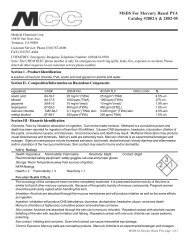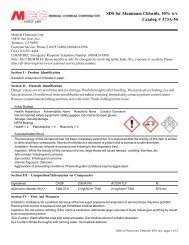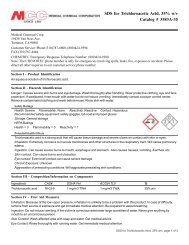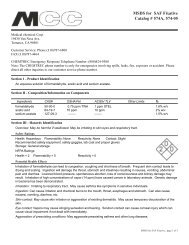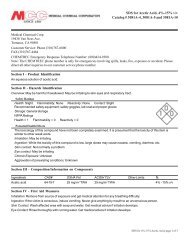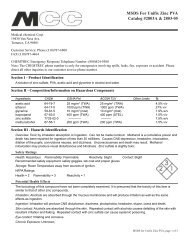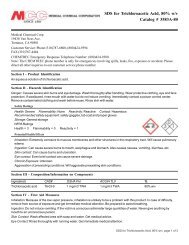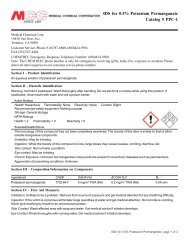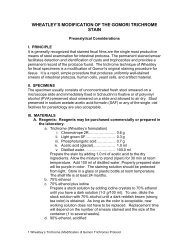MSDS - Medical Chemical Corporation
MSDS - Medical Chemical Corporation
MSDS - Medical Chemical Corporation
You also want an ePaper? Increase the reach of your titles
YUMPU automatically turns print PDFs into web optimized ePapers that Google loves.
KIT CONTENTS<br />
100 vial (15 ml) UNIFIX TM<br />
1 10-language instruction sheet<br />
MATERIALS NOT PROVIDED<br />
ethyl acetate, saline<br />
applicator sticks and cotton tipped applicator<br />
transfer pipets<br />
concentration system (Sed-Connect TM , Para-<br />
Sed TM , Micro-Sed TM )<br />
centrifuge<br />
microscope, slides and cover slips<br />
trichrome reagents<br />
5% formalin, 10% formalin or physiological saline<br />
COLLECTION<br />
1. Collection of fecal specimens for intestinal parasites<br />
should always be performed prior to the use of any antacids,<br />
barium, bismuth, antidiarrheal medication, or oily<br />
laxatives.<br />
2. Routine examination for parasites prior to treatment, a<br />
minimum of three specimens, collected on alternate<br />
days, is recommended. Two of the specimens should be<br />
collected after normal movements, and one after a cathartic,<br />
such as magnesium sulfate or fleet<br />
Phospho-Soda. If the patient has diarrhea, do not use a<br />
laxative.<br />
3. Fecal specimens should be collected in a clean, dry<br />
wide mouthed container; a bedpan is ideal. However a<br />
waxed, cardboard half-pint container with a tight-fitting<br />
lid, a clean, dry milk carton with the top two thirds removed<br />
or a plastic bag or plastic wrap placed over the<br />
toilet seat opening is acceptable. Contamination with<br />
urine should be avoided.<br />
4. Small samples of the specimen should be placed into<br />
the vial using the spork built into the lid of the vial. Pay<br />
particular attention to the areas that appear bloody or<br />
contain a lot of mucus. Add samples until the fluid level<br />
reaches the red “fill line”. This will insure the appropriate<br />
three to one ratio of fixative to sample.<br />
5. Use the spork to thoroughly stir and mix the stool with<br />
fixative. Recap the vial, making sure the lid is securely<br />
fastened. Firmly shake the vial until contents are thoroughly<br />
mixed (the solution should appear homogeneous).<br />
6. Fill out the patient information on the side of each<br />
vial. Reseal the vials in the plastic bag. Caution: Every<br />
sample should be treated as a potential source of contamination.<br />
EXAMINATION<br />
The use of UNIFIX allows for a wide variety of examination<br />
procedures including gross examination (only if the<br />
kit contains a clean vial), direct microscopic examination,<br />
permanent staining, and concentration procedures.<br />
Macroscopic examination<br />
Examine the contents of the clean vial (unpreserved<br />
specimen) and record the consistency of the specimen,<br />
the presence of worms or proglottids, and blood if any.<br />
Microscopic examination<br />
Direct smears from UNIFIX preserved specimen. Prepare<br />
the smear by mixing a small amount of preserved<br />
fecal material (approximately 2 mg) with a drop of physiologic<br />
saline on a glass slide. Cover with a 22 by 22 mm<br />
coverslip. Examine the entire coverslip immediately using<br />
the low powered objective. Suspect objects may be<br />
examined under high-dry power. Since the fecal material<br />
has been preserved, there will be no organism mobility<br />
visible (the purpose of the direct wet mount). With preserved<br />
material, the routine Ova and Parasite examination<br />
can begin with the fecal concentration rather than<br />
the direct wet mount.<br />
Permanent stain and concentration procedure using<br />
MCC’s Para-Sed (50 ml) and Sed-Connect (15 ml)<br />
Mix contents of the UNIFIX vial thoroughly.<br />
1. Remove the cap from the UNIFIX vial and add 8-10<br />
drops of surfactant. Recap the vial making sure the lid<br />
is securely fastened.<br />
2. Mix the contents of the vial by shaking vigorously, or<br />
vortexing for 30 seconds.<br />
3. With the 50 ml centrifuge vial or 15 ml vial still loosely<br />
attached to the filter unit (loose attachment will facilitate<br />
the release of air pressure during use), insert the open<br />
end of the filter unit into the specimen vial until the sealing<br />
ring is firmly seated. Tighten the 15 ml or 50 ml centrifuge<br />
vial onto the filter unit.<br />
4. Invert the tube and filter the specimen through the<br />
mesh into the 15 ml or 50 ml centrifuge tube. If the flow<br />
does not start immediately, or the specimen is thick, the<br />
flow may be initiated by sharply tapping the centrifuge<br />
tube on a counter top.<br />
5. After filtration is complete, tap the centrifuge tube on<br />
the counter top 2 or 3 times to insure that all the fluid<br />
(Par-Sed) or 3-5 ml of material (Sed-Connect) has<br />
drained into the tube. Tilt the filter unit at a slight angle.<br />
Unscrew the concentrator unit and specimen vial and discard<br />
using established laboratory procedures for fecal<br />
specimens.<br />
6. Place the screw cap on the 50 ml centrifuge tube or<br />
push cap on the 15 ml centrifuge tube and centrifuge for<br />
10 min at 500xg (1800-2000 rpm for most table top centrifuges).<br />
7. Decant. Mix the remaining UNIFIX preserved sediment<br />
with a applicator stick.<br />
8. Prepare a slide for permanent staining by adding a<br />
small sample of the suspended sediment to the slide.<br />
The sediment can also be used to prepare smears for<br />
special staining (modified acid-fast for coccidia or modified<br />
trichrome for the microsporidia).<br />
9. Spread the sample over the slide to prepare a thin<br />
smear which varies in thickness. Allow to dry overnight<br />
at room temperature or for several hours (minimum of<br />
30min; 60 min if slide is thicker) in a 37 o C incubator or<br />
slide warmer (smear will appear opaque when dry). Do<br />
not use a heating block ; the temperature will be detrimental<br />
to any organisms present.<br />
10. Proceed with staining regimen of choice. We recommend<br />
Wheatley’s Gomori Trichrome stain although<br />
iron hematoxylin may also be used.<br />
Staining Procedure<br />
1. Place in Trichrome stain 6-10 minutes.<br />
2. Dip twice in 90% alcohol with 0.5% acetic acid. If<br />
the slide appears pale, substitute 90% alcohol without<br />
acid or stain longer.<br />
3. Place in two changes of 100% alcohol for 2 to 5 minutes.<br />
4. Place in two changes of xylene or xylene substitute<br />
for 5 to 10 minutes.<br />
Concentration Procedure using MCC Para-Sed #695A<br />
1. To the remaining sediment from step 8 above add<br />
saline (5% or 10% formalin may be used instead) to<br />
bring the level of the filtered sediment to the fill line on<br />
the Para-Sed centrifuge tube.<br />
2. Add approximately 3 ml-5 ml of ethyl acetate (or<br />
other ether substitute) and recap the tube with cap provided<br />
with the kit.<br />
3. Hold the tube so that is directed away from your<br />
face and shake vigorously for 30 seconds. If diethyl<br />
ether is used (not recommended) pressure may build<br />
up during shaking, and the cap should be carefully<br />
loosened after shaking to release the pressure and<br />
then retightened.<br />
4. Centrifuge at 500Xg for 10 min.<br />
5. Carefully remove the stopper. The resulting solution<br />
should have four layers:<br />
Top: ethyl acetate or ethyl ether<br />
Second: debris plug<br />
Third: saline (or formalin)<br />
Fourth: sediment<br />
6. Ring the debris layer with an applicator stick to<br />
loosen the debris. Invert the tube to pour off the<br />
supernatant fluid and debris layer. While tube is still<br />
inverted use a cotton tipped applicator to clean the<br />
sides of the tube, making certain to remove any ethyl<br />
acetate or debris left behind. Failure to remove the excess<br />
ethyl acetate may result in the formation of solvent<br />
bubbles in the wet mount. The sediment at the<br />
bottom of the tube will contain the parasites.<br />
7. Resuspend the remaining sediment with a few drops<br />
of 5% or 10% formalin or saline.<br />
8. To prepare a wet mount, draw a sample from the resuspended<br />
material with a capillary or transfer pipette.<br />
Place one or two drops on a microscope slide and<br />
cover with a coverslip. Examine immediately.<br />
9. If an iodine mount is preferred, place one drop of<br />
Lugol’s iodine on a slide, and one drop of the
esuspended material. Place a coverslip on the slide<br />
and examine immediately.<br />
10. If smears will be prepared for special staining<br />
(Cryptosporidium spp, Isospora belli, Cyclospora<br />
cayetanensis, or the microsporidia), the remaining sediment<br />
can be used for making the smears.<br />
If using a Sed-Connect or Micro-Sed for concentration<br />
use the following procedure.<br />
Thoroughly mix the contents of the UNIFIX vial. Proceed<br />
with the specimen processing instructions in the<br />
Micro-Sed or Sed-Connect instruction sheet. NOTE: You<br />
may skip steps 6&7ifyouprefer a single wash.<br />
If neither MCC Para-Sed, Micro-Sed or Sed-Connect are<br />
available the following procedure for permanent slides<br />
and concentration may be used:<br />
1. Mix the material in the UNIFIX vial thoroughly.<br />
2. Strain approximately 2-3 ml of the fixed material<br />
through the gauze into a 15 ml centrifuge tube.<br />
3. Centrifuge for ten min. at 500xg.<br />
4. The sediment should be approximately 1 ml in volume.<br />
Decant the supernatant fluid.<br />
5. Mix the sediment and prepare a permanent slide as<br />
described above.<br />
6. Use the remaining sediment for your method of concentration.<br />
PRECAUTIONS<br />
1. Ethyl acetate and diethyl ether are flammable. Use in<br />
a well ventilated area. Keep away from direct flame.<br />
Avoid contact of the solution with skin and eyes. Should<br />
contact occur flush with running water. Avoid breathing<br />
fumes.<br />
2. Avoid contact of UNIFIX solution with skin or eyes. If<br />
contact occurs, flush effected area with water. If irritation<br />
develops contact a physician immediately.<br />
3. UNIFIX solution is poisonous. If ingestion occurs<br />
drink milk or water. Contact a physician immediately.<br />
4. Every sample should be treated as a potential source<br />
of infection. Good laboratory practice should be followed<br />
at all times. The use of gloves and hand washing<br />
is recommended.<br />
STABILITY<br />
The expiration date of each kit is printed on the outer label.<br />
The expiration dates of each vial are printed on the<br />
individual vial label. The kits should be stored at room<br />
temperature. If the UNIFIX vials are exposed to freezing<br />
temperatures for an extended period of time they will<br />
freeze. If the vials are restored to room temperature,<br />
there will be no change in performance.<br />
BIBLIOGRAPHY<br />
1. Brooke, M.M., 1974. “Intestinal and Urogenital Protozoa”,<br />
Manual of Clinical Microbiology, ASM, Washington,<br />
D.C., Second Edition, 582-601.<br />
2. Garcia, L.S. 2009. Practical Guide to Diagnostic Parasitology,<br />
2nd ed., ASM Press, Washington D.C.<br />
3. Garcia, L.S. 2007. Diagnostic <strong>Medical</strong> Parasitology,<br />
5th ed., ASM Press, Washington, D.C.<br />
4. Garcia, L.S. (Coordinating Editor), 2003. Selection<br />
and Use of Laboratory Procedures for Diagnosis of Parasitic<br />
Infections of the Gastrointestinal Tract, Cumitech<br />
30A, ASM Press, Washington, D. C.<br />
5. Melvin, D.M., and M.M. Brooke. 1982 Laboratory Procedures<br />
for the Diagnosis of Intestinal Parasites, 3rd ed.<br />
U.S. Department of health, Education and Welfare Publication<br />
no. (CDC) 82-8282. Government Printing Office,<br />
Washington, D.C<br />
6. National Committee for Clinical Laboratory Standards,<br />
1997, Procedures for the Recovery and Identification of<br />
Parasites from the Intestinal Tract, 2nd ed., Approved<br />
Guideline, M28-A National Committee for Clinical Laboratory<br />
Standards, Villanova, PA..<br />
7. Scholten, Th., 1972. An Improved Technique for the<br />
Recovery of Intestinal Protozoa. J. Parasitol.<br />
58:603-634<br />
8. Yang, J., and Th. Scholten, 1977. A Fixative for Intestinal<br />
Parasites Permitting the Use of Concentration and<br />
Permanent Staining Procedures. Am. J. Clin. Pathol.,<br />
67:300-304.<br />
OTHER MEDICAL CHEMICAL PRODUCTS<br />
CATALOG #<br />
Z-PVA Vials 2802-05<br />
LV-PVA Vials 2803-05<br />
SAF Vials 574-05<br />
C&S Medium Vials 2805-05<br />
Clean Vials 310<br />
Para-Sed TM (50 ml concentration system) 695A<br />
Micro-Sed TM (15 ml concentration system) 694A<br />
Sed-Connect TM (15 ml, 50 ml closed system) 693A<br />
(with ethyl acetate)<br />
Wheatley’s Gomori Trichrome<br />
Modified Trichrome Blue for Microsporidia<br />
Iron Hematoxylin 1<br />
Iron Hematoxylin 2<br />
D’Antoni Iodine<br />
Giemsa Stain<br />
Giemsa Buffer<br />
We also carry:<br />
Gram Stains<br />
AFB Stains<br />
Fluorescent AFB Stains<br />
Quality Control Slides<br />
QC Organisms<br />
Revision date: Apr. 23, 2009<br />
693A-E<br />
602A<br />
601A<br />
6185A<br />
6188A<br />
628A<br />
591A<br />
592A<br />
<strong>Medical</strong> <strong>Chemical</strong> <strong>Corporation</strong><br />
19430 Van Ness Ave.<br />
Torrance, CA 90501<br />
Phone (310) 787-6800<br />
Phone (800) 424-9394<br />
Fax (310) 787-4464<br />
UNIFIX TM<br />
Stool Collection System<br />
Catalog # 2804-05<br />
INTENDED USE<br />
The UNIFIX stool collection kit is a single vial system<br />
that provides a standardized method for untrained personnel<br />
to properly collect and preserve stool specimens<br />
for the detection of helminth larvae and eggs, protozoan<br />
trophozoites and cysts, coccidian oocysts, and<br />
microsporidian spores. Permanent stain and concentration<br />
may be performed from a UNIFIX preserved specimen.<br />
A ten language instruction sheet is provided to<br />
assist patients or healthcare professionals with the<br />
proper use of the kits at home or in the hospital.<br />
SUMMARY AND EXPLANATION<br />
The diagnosis of intestinal parasitic infection is confirmed<br />
by the recovery of helminth larvae and eggs,<br />
protozoan trophozoites and cysts, coccidian oocysts,<br />
and microsporidian spores. The ability to detect and<br />
identify intestinal parasites in fresh stool specimen depends<br />
on immediate collection, transportation, and examination<br />
by the laboratory, all of which are difficult to<br />
guarantee. The use of a stool preservative is highly recommended<br />
to preserve parasite morphology during situations<br />
where time constraints for collection, delivery and<br />
examination cannot be reasonably met.<br />
UNIFIX is a mercury and formalin free fixative that preserves<br />
parasite morphology and helps with disposal and<br />
monitoring problems encountered by laboratories. A<br />
clean vial can be incorporated for collection of<br />
unpreserved specimens, for examination for stool fat,<br />
occult blood, enteric or amebic culture.



